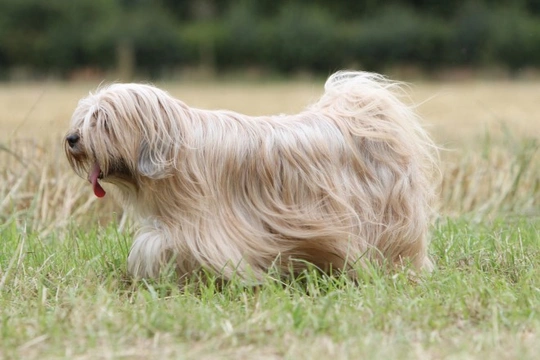
Tibetan terrier hereditary health and longevity
The Tibetan terrier is a medium sized dog breed which, as the name suggests, hails from Tibet. However, the second part of their name is something of a misnomer, as they are not actually members of the terrier group at all! Their physical resemblance to dogs of the terrier type first gave the breed its name, but in reality, the Tibetan terrier falls into the utility dog grouping.
They are powerful and strong for their size, with square-ish proportions, and quite a lot of variance possible in terms of their height and weight. They can stand up to 41cm tall at the withers, and weigh up to 14kg, with males and females tending to be around the same size.
They have shaggy, feathered coats that should be neither harsh nor silky, and that is particularly long over the face, with feathering on other areas of the body too. The tail is curved and carried over the back, and they have broad, flat feet with lots of hair between their toes, which helps them to get to grips with scaling the often snowy mountainous terrain of their home region.
The breed itself is one of the most ancient of all dog breeds, and DNA analysis of the breed indicates that Tibetan terrier ancestry is present across a wide range of more modern breeds of dogs too. They were first kept by Buddhist monks in monasteries, and as such, have earned the title of the “holy dogs of Tibet.”
If you are wondering if a Tibetan terrier is the right choice of dog for you, it is important to do plenty of research into the breed before committing to a purchase, and in this article we will look at the hereditary health and average longevity of the breed in more detail.
Tibetan terrier lifespan
The average longevity of the Tibetan terrier is 12 years, which places the breed firmly in the middle of the average rankings across the board of all breeds of dog of a similar size and build. However, survey data indicates that around one in five dogs of the breed will live to over 15 years, and the oldest recorded Tibetan terrier lived to over 18.
Genetic diversity
The coefficient of inbreeding statistic for the Tibetan terrier is 7.6%, which is slightly higher than the 6.25% or below that is the accepted ideal for pedigree dog breeds. While the Tibetan terrier is only a touch higher than this figure, Tibetan terrier breeders should seek to reduce this figure where possible within their own breed lines.
Conformation
The Tibetan terrier is a fairly squarely built and well-padded dog, and it is important to get the balance right when it comes to their food and exercise to avoid them running to fat. The long, shaggy hair of the Tibetan terrier can also grow long enough to obscure the dog’s vision, and so may require trimming and clipping.
Their coats also tend to hold dirt and debris, and benefits from regular combing and brushing to keep it in good condition.
Health testing for the Tibetan terrier
The Kennel Club, the British Veterinary Association and Tibetan terrier breed clubs monitor the health of dogs of the breed, and work to identify problems that are prevalent across the breed with a view to reducing their occurrence rate. Where hereditary health problems are identified, pre-breeding health screening may be possible to find out the propensity to a hereditary condition being passed on prior to breeding. This allows breeders to make an informed choice on whether or not to breed from their dogs.
Health schemes and DNA tests available for the Tibetan terrier include:
- Hip score testing, with the breed’s mean hip score being 12. Parent dogs of the breed should receive a hip score below this figure in order to be considered viable.
- A range of eye conditions can also present across the breed, including hereditary cataracts, primary lens luxation, progressive retinal atrophy, and glaucoma.
- DNA testing is available for primary lens luxation.
- DNA testing is available for neuronal ceroid lipofuscinosis, a neurological condition that can lead to seizures.
- DNA testing is available for progressive retinal atrophy.
- DNA testing is available for renal dysplasia, a kidney condition that can lead to renal dysfunction.
Other health issues
As well as the conditions listed above that have a known hereditary factor to them and can be tested for, a small range of other conditions may also afflict the Tibetan terrier breed with some regularity, but for which no pre-breeding health screening is available. Such conditions include:
- Type one diabetes, an insulin production disorder.
- Congenital deafness.
- Cataracts of the eyes, most commonly in old age.
- Distichiasis, a condition in which the eyelashes grow a second row, which can rub on the eye and cause sores and irritation.
- Lysosomal storage disease, due to a deficiency of certain liver enzymes.



